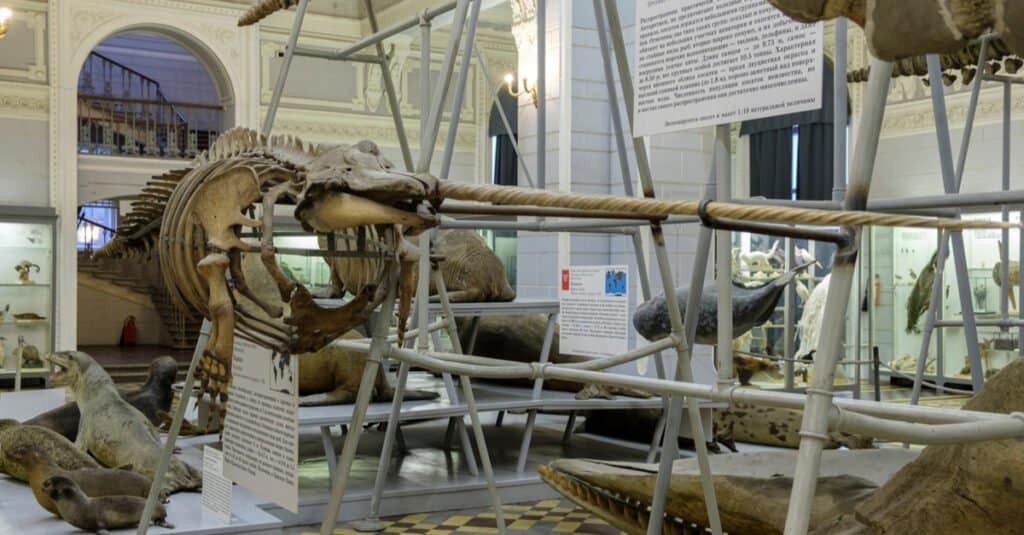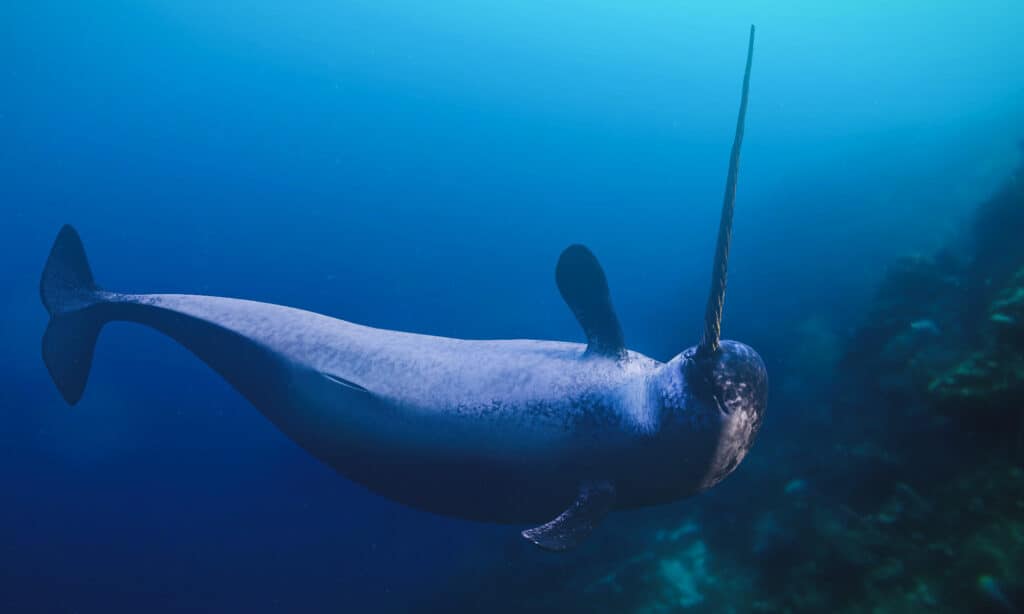The narwhal, also called a narwhale (Monodon monoceros), is a medium-sized toothed whale with a prominent canine tooth that serves as its “tusk.” Monodon monoceros is the narwhal’s official scientific name. This phrase has Greek origins and means “one tooth, one horn.” Theoretically, the term narwhal can apply to the species or the genus. The only species in this genus existing is the narwhal. These animals belong to the family Monodontidae, and the beluga whale is the only other member of the family that is still alive. However, narwhals also share a close relationship with all other whales, dolphins, and cetaceans.
The Old Norse term nar, which means corpse, is where the animal gets its name. This name is a reference to the animal’s light color. Other names these animals are called include narwhale or narwal. These creatures hunt for prey in the Arctic Ocean and Northern Atlantic’s frigid waters. Sometimes they come up for air in bigger groups, providing tourists and other bystanders with a mesmerizing view. Although humans have historically persecuted this species for its abundant resources, it is not currently in danger of extinction.
Have you ever wondered what the inside of this animal’s mouth looked like because of its tusk? Keep reading to find out whether or not they have teeth and how they use them.
How To Identify Narwhals

Narwhals have a prominent tusk on their skull, inverted flippers, and a dorsal ridge rather than a genuine fin on the back.
©iStock.com/dottedhippo
The narwhal is an animal that resembles a tiny whale in many respects. However, their bodies are considerably smaller than those of other cetaceans. A prominent tusk on its skull, inverted flippers, and a dorsal ridge rather than a genuine fin on the back are primary distinguishing characteristics of the narwhal.
Narwhals can have different colors during their lifetime- at birth, they are a dark blue or gray color. As they age, they take on a whiter, speckled pattern across their stomach and sides. They also live and travel in sizable pods of up to 20 or 25 individuals. These pods combine to create a group of hundreds or even thousands of individuals during the migration season.
Through various whistles, clicks, and knocks produced by the air movement between chambers close to the blowhole, they can communicate with one another and receive information about their surroundings, including the location of potential prey.
Do Narwhals Have Teeth?

Unlike all other toothed whales, the narwhal lacks teeth in its mouth.
©Vovantarakan/Shutterstock.com
The narwhal is an odontocete or toothed whale. However, unlike all other toothed whales, it lacks teeth in its mouth. Instead, the male narwhal’s upper left jaw is protruded two to three meters by a single long, straight tooth or tusk. Almost rarely do females possess tusks. The tusk is a large canine tooth that may grow up to 10 feet long, has a unique left-hand spiral, and is covered with cementum, a tissue often only seen at the base of teeth embedded in bone.
Canine teeth are utilized as weapons or to hold food in the mouths of the majority of animals. The male narwhal’s long spiral tusk is one of a pair of canine teeth arranged horizontally in the animal’s head. Because the tusk begins in the maxillary bone of the narwhal, where canine teeth in mammals originate, scientists were able to determine that it was a canine and not an incisor. This validation made the tusk’s identity as a canine tooth official for the first time.
The tooth that develops into a long tusk and emerges through the narwhal’s upper lip is the left one of the pair. Although it is firmly implanted in the narwhal’s skull, the right canine tooth is a tusk. Only seldom do both tusks emerge. On open tooth sockets in the narwhal’s snout, next to the tusks, are the second set of tiny teeth. These teeth are vestigial, which means they serve no purpose.
How Do Narwhals Eat?
The narwhal consumes squid, shrimp, cod, halibut, and other types of fish as part of a highly specialized diet. Seasonal changes have a big impact on diet. It may consume very little during the summer and rely on its fat reserves instead. Because they have no teeth in their mouth they use to chew food, these animals tend to swallow their food whole. They use echolocation to assist them to find food. They have an intriguing method of feeding that involves creating a type of vacuum and sucking up their food.
Like other whales, narwhals are mammals. This means they give birth to their young alive. Baby narwhals are referred to as calves. Calves live off of the milk produced by their mothers for up to two years before they start hunting alongside adult members of their pod.
How Do Narwhals Use Their Tusks?

Narwhals’ tusks can grow as long as 10 feet.
©Dotted Yeti/Shutterstock.com
The narwhal’s tusk is actually a tooth with millions of nerve endings inside it. With almost 10 million nerve endings, it is an excellent sensory organ that can gather information about water pressure, temperature, and salinity. Although narwhals do not use their tusks to eat, these tusks still have alternate uses.
Narwhals’ tusks can grow as long as 10 feet and in some cases, males use their tusks to stun their prey. Scientists believe that male narwhals use their tusks to hunt their prey before swallowing them whole. Although some believe that these large mammals once had teeth like most other mammals, there is no evidence proving such.
Narwhals also use their horns to attract mates. Their tusks are almost like a peacock’s ostentatious feathers or an elk’s elaborate antlers. At some point, scientists thought that males used their tusks to duel for the attention of a mate, but that is not the case. Narwhals also engage in a practice known as tusking, in which one bull rubs its tusk against another bull. This practice may be related to social dominance or sensory information communication. Also, because narwhals can be found in the Arctic waters, they sometimes use their tusks to break the ice if they happen to be trapped under it.
Up Next:
The Narwhal Tusk: The World’s Longest Tooth
Narwhal Skull: How Its Massive Tusk Connects
The photo featured at the top of this post is © iStock.com/dottedhippo
Sources
- Ocean Syrup, Available here: https://oceansyrup.com/narwhals-teeth/
- Collins Dentistry & Aesthetics, Available here: https://www.wemakespokanesmile.com/blog/tooth-sensitivity-may-be-a-bonus-to-narwhals/
- Arctic Kingdom, Available here: https://arctickingdom.com/narwhal-tusk-facts-did-you-know/
Thank you for reading! Have some feedback for us? Contact the AZ Animals editorial team.







